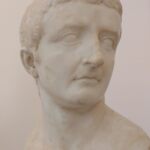In 1993, an ancient cemetery was found in Ephesus (western part of Turkey), the former capital of the Roman province of Asia. Scientists had two suspicions suggesting that this is a mass grave of gladiators.
- Ephesus was the place where gladiator fights took place – we have many artifacts from this place, including graffiti, indicating that they have taken place since 69 BCE.
- Most of the buried remains had critical injuries, indicating death after dramatic events.
Ephesus was once a powerful eastern city with over 200,000 inhabitants. The mass grave found had an area of approximately 19m2, in which a total of over 60 people were buried, of which 22 gladiators and 31 other people buried on the spot, not fighting in the arena, were examined. The burial site was on the road leading to the temple of Artemis – the Greek goddess of hunting; this building was one of the famous seven wonders of the world.
Scientists conducted detailed studies of the bones and skulls of the buried bodies for comparison purposes. The conclusions were surprising: the gladiator diet was, in our opinion, very vegetarian and rich in carbohydrates. After the isotope analysis, it turned out that gladiators ate much more vegetables and less meat compared to the rest of the city’s inhabitants. Hence the colloquial term for gladiators – hordearii, or “eating barley”.
What’s more, the gladiators were not perfectly muscled men, but rather had significant amounts of fat. They ate mainly wheat, barley (of rather inferior quality), legumes (e.g. broad beans) in order to acquire significant amounts of subcutaneous fat. It was extremely helpful in the arena, because it protected the most important parts of the body such as ligaments, nerves, blood vessels from cutting. This guaranteed a better spectacle for the masses because the gladiators were wounded, cut and bloody bodies were visible, but they were still fighting in the arena.
A diet based on cereal products, however, caused significant calcium deficiencies. To keep the bones strong, a special decoction of charred wood (or plants) and bone ash, which was very rich in calcium, was drunk. In this way, the bones could regenerate faster and were much more durable. Compared to the bones of the other inhabitants of Ephesus, gladiators had really strong bones. So it was an early form of supplementation.
Researchers also performed a bone pre-cut. Many gladiators died after being hit in the head. Three skulls were pierced by tridents, a weapon used by retiarus – a lightly armored warrior who also had a net that he threw at his opponent to bind him. Most often his rival was murmillo – a heavily armored walker who had a helmet and a large shield. Ten other men died of strong blows with a blunt weapon – it was possible that they were hammers used for the final death.
The other men died according to the “best” patterns: after a hard fight, which gladiators paid for with many cut wounds, the defeated rival ended his life, being stabbed in the heart with his blade.








